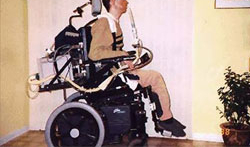Resumo
Definição
História e exame físico
Principais fatores diagnósticos
- presença de fatores de risco
- distribuição irregular de força nos membros inferiores
- contraturas musculotendinosas nos membros inferiores
- desenvolvimento motor tardio
- hipertrofia da panturrilha
- dificuldade de deambulação e quedas
- tônus muscular e reflexos tendinosos profundos diminuídos
- sensibilidade normal
- sinal de Gower
Outros fatores diagnósticos
- caminhar na ponta dos pés
- hipotonia
- hiperatividade
- incontinência urinária e intestinal
- deficiência intelectual leve a grave
Fatores de risco
- história familiar
- sexo masculino
Investigações diagnósticas
Primeiras investigações a serem solicitadas
- creatina quinase (CK) sérica
- teste genético
Investigações a serem consideradas
- eletromiografia (EMG)
- biópsia muscular
- RNM muscular
Algoritmo de tratamento
DMD: estágio deambulante
DMD: estágio não-deambulante inicial
DMD: estágio não-deambulante tardio
atrofia muscular espinhal (AME)
Colaboradores
Autores
Pinki Munot, MD
Consultant Paediatric Neurologist
Great Ormond Street Hospital for Children
London
UK
Declarações
PM PM is a principal investigator for the Sideros trial in DMD and the ARGNX trial in Myasthenia, and a sub-investigator for the SHINE trial. PM was reimbursed for presenting at the PULSE 65 rare disease day for GPs in December 2023 and for the RCPCH 2022 lunch time symposium by PTC therapeutics.
Agradecimentos
Dr Pinki Munot would like to gratefully acknowledge Dr John R. Bach, Dr Aravindhan Veerapandiyan, and Dr Bilal Saulat, previous contributors to this topic.
Declarações
JRB, AV, and BS declare that they have no competing interests.
Revisores
Lisa D. Hobson-Webb, MD
Assistant Professor of Medicine
Department of Medicine/Neurology
Duke University Medical Center
Durham
NC
Declarações
LDH-W declares that she has no competing interests.
Martin K. Childers, DO, PhD
Associate Professor Neurology and Regenerative Medicine
Wake Forest University Health Sciences
Winston-Salem
NC
Declarações
MKC declares that he has no competing interests.
Adnan Manzur, FRCPCH
Consultant Paediatric Neurologist
Great Ormond Street Hospital for Children NHS Trust
London
UK
Declarações
AM has been paid an honorarium for giving lectures at the Imperial College Educative Training Courses for GPs and post-graduate doctors. AM is the lead author of the Cochrane review of corticosteroids in Duchenne muscular dystrophy. He is also the Lead Clinician of the NorthStar Clinical Network for Management of Neuromuscular Disorders in the UK.
Richard W. Orrell, BSc, MD, FRCP
Senior Lecturer and Consultant Neurologist
Department of Clinical Neuroscience
UCL Institute of Neurology
London
UK
Declarações
RWO is an author of a reference cited in this topic.
Referências
Principais artigos
Birnkrant DJ, Bushby K, Bann CM, et al; DMD Care Considerations Working Group. Diagnosis and management of Duchenne muscular dystrophy, part 1: diagnosis, and neuromuscular, rehabilitation, endocrine, and gastrointestinal and nutritional management. Lancet Neurol. 2018 Mar;17(3):251-67.Texto completo Resumo
Birnkrant DJ, Bushby K, Bann CM, et al; DMD Care Considerations Working Group. Diagnosis and management of Duchenne muscular dystrophy, part 2: respiratory, cardiac, bone health, and orthopaedic management. Lancet Neurol. 2018 Apr;17(4):347-61.Texto completo Resumo
Birnkrant DJ, Bushby K, Bann CM, et al; DMD Care Considerations Working Group. Diagnosis and management of Duchenne muscular dystrophy, part 3: primary care, emergency management, psychosocial care, and transitions of care across the lifespan. Lancet Neurol. 2018 May;17(5):445-55.Texto completo Resumo
Feingold B, Mahle WT, Auerbach S, et al. Management of cardiac involvement associated with neuromuscular diseases: a scientific statement from the American Heart Association. Circulation. 2017 Sep 26;136(13):e200-31.Texto completo Resumo
Gloss D, Moxley RT 3rd, Ashwal S, et al. Practice guideline update summary: corticosteroid treatment of Duchenne muscular dystrophy: report of the Guideline Development Subcommittee of the American Academy of Neurology. Neurology. 2016 Feb 2;86(5):465-72.Texto completo Resumo
Artigos de referência
Uma lista completa das fontes referenciadas neste tópico está disponível para os usuários com acesso total ao BMJ Best Practice.

Diagnósticos diferenciais
- Polimiosite
- Encefalopatias estáticas (paralisia cerebral)
Mais Diagnósticos diferenciaisDiretrizes
- Diagnosis and management of Duchenne muscular dystrophy, part 1: diagnosis, and neuromuscular, rehabilitation, endocrine, and gastrointestinal and nutritional management
- Diagnosis and management of Duchenne muscular dystrophy, part 2: respiratory, cardiac, bone health, and orthopaedic management
Mais DiretrizesConectar-se ou assinar para acessar todo o BMJ Best Practice
O uso deste conteúdo está sujeito ao nosso aviso legal